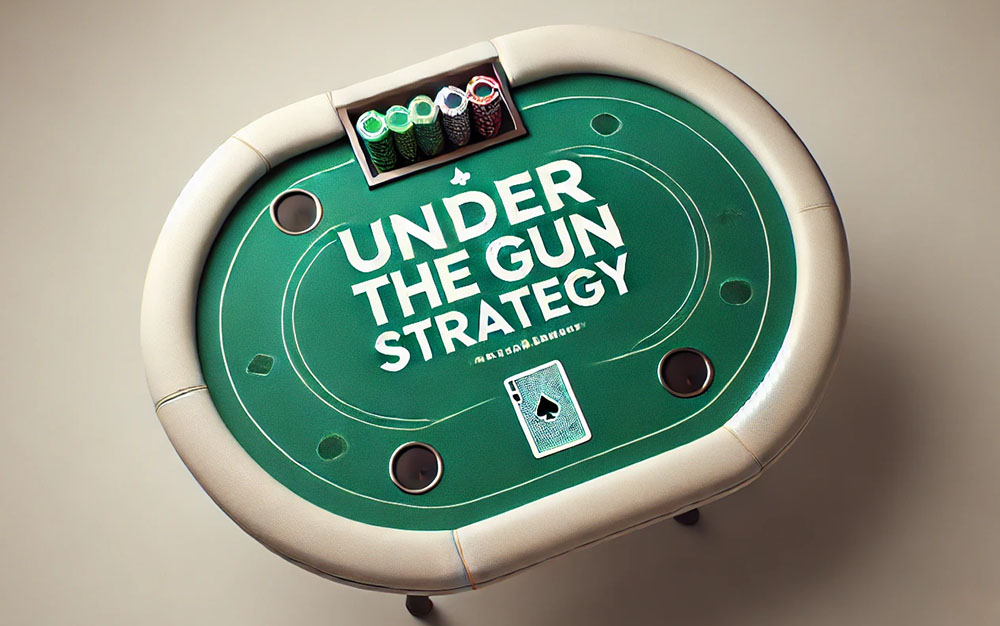Under the gun strategy in poker

If you are a poker player, you’ve faced the dilemma of what to do when playing Under the Gun. Don’t feel bad, most poker players have trouble when playing in this early position. What does Under the Gun mean? This is the player immediately to the left of the big blind is called the Under the Gun player. It’s the first person to act as soon as the cards are dealt.
Being “under the gun” is the most dangerous position at the poker table for several reasons:
- Positioning – When you’re under the gun, you are first to act before the flop and one of the first to act after the flop. Being that poker is a game that relies on information, you are getting the worst of it in this position.
- You can be played with – Because of your bad position, other players can take advantage by check-raising you, trapping you, and getting better information out of you.
- You are vulnerable – In Under the Gun position, you are more likely to get bluffed, pushed around, raised and just plain beaten.
What is so bad about being under the gun?
Let’s look at an example of being under the gun in poker to see why it’s bad. You’re the under the gun player at a 9-man table in a no-limit game. You get your cards and look down at an A-10 off-suit. You decide to limp in, and you call the big blind of $4. The action goes around the table to the other players. The man on the button, Harry, decides to raise and make it $12 to play. Since Harry is on the button, he could be raising with a variety of hands and may just be making a play at the pot. With this logic, you decide to call and see a flop. The blinds both fold and one other player calls. The flop comes out:A,3,6 – all different suits. You have top pair, medium kicker. So what do you do? If you bet out, you are likely to get raised at least once. Plus, since you’re first to act, you don’t have any idea of what the other players will do. I mean, you hit top pair in a raised pot. Harry calls, and the other guy folds.
At this point, you still don’t know where you stand. The turn comes. It’s an 8.You decide to check this time and Harry fired $60 into the pot. At this point, you’re “pot committed” and you still have top-pair, so you decide to call. The river comes and it’s a 9. you decide to check again, and Harry goes all-in for $150 more. You’ve already got about 80 in the pot. You’re getting over 2:1 on your money, and you’re really not sure if Harry’s bluffing or not.
You reluctantly call and lose to Harry’s Big Slick and takes in the pot. You didn’t lose this hand only because of the cards. You lost because your positioning throughout the hand was terrible. If you’re under the gun and you hit top pair on the flop, you’re just asking for trouble because you don’t have any other information available other than your cards.
Online poker has in a lot of ways changed the game, with much more aggressive play, however being under the gun is still a tough proposition without an outstanding hand.
Red flags for under the gun poker play
More often than not, playing Under the Gun is a money drain. You can lose hands in all of the following ways playing under the gun in Texas Hold’em:
- You call the blinds, but then the pot gets raised before the flop and you fold. (You’ve lost your blinds.)
- if you have a good hand but someone else has a monster and slow-plays you.
- You call the blinds and a pre-flop raise and you miss the flop completely so you check, and there’s a big bet by another player and you are forced to fold.
- If you bet after the flop but get raised and are forced to fold.
Think about all the times these scenarios happen when you’re Under the Gun in Texas Hold’em and what you have are many lost chips. I’m not implying that you should fold every time you’re under the gun. It’s all about hand selection. In the example I gave, you never should have been playing that hand in the first place with such a mediocre holding. So I suggest, when in early position, tighten up and only play solid starting hands such as AK, AQ, KQ and pairs. You may also play an occasional suited connector from time to time as well.
Hands you should play when under the gun
If you don’t have one of the following sets of cards, move forward in the under the gun position warily. Below
- Group 1: AA, KK, QQ, and AK.
- Group 2: AQ, KQ, and all other pairs.
Whenever you have one of the hands from group 2, just call, never raise. What you’re trying to do is hit something good on the flop. You may also call a moderate raise with these hands. Forget about hands like A-J or K-10 as these will only lead to trouble. By playing small pocket pairs, if you hit your set, you will normally be paid off handsomely.
Now let’s talk about Group 1 hands. You should play these hands depending on the type of game you’re in. If you’re at a table with lots of pre-flop raising, limp in with these and if there isn’t lots of pre-flop action, raise with them. Why? Well, if you limp in and someone is likely to raise, you can then come over the top when the action comes back to you. You are maximising the amount of money in the pot for your big holding. Now if the table is tight, you want to make a raise under the gun because you don’t want a bunch of players to all limp-in and see a cheap flop.
Summary of Under the Gun poker strategy
While developing your own Texas Hold’em Under the Gun strategy is crucial, you can guarantee the following poker strategy will be employed in part or full. Modern game theory has changed how players bet out of position, but under the gun remains one of the toughest spots to nail.
Remember these under the gun poker strategy tips and you should be fine:
- Only play premium hands: pairs, AK, AQ, or KQ.
- With AA, KK, QQ, and AK, you should raise at a tight table and limp at a loose table.
- With the other starting hands you should just limp.
- If you follow this advice, you can improve your odds from the dangerous under the gun position in poker and you’ll have an advantage over everyone at the table.
- The most important thing to remember when playing from under the gun in poker is to play tight, because it is really is a hard position to win hands from. In turn, it’s usually a good indicator that someone has a strong hand if they raise under the gun.



